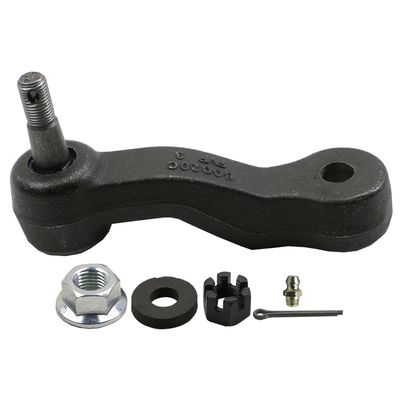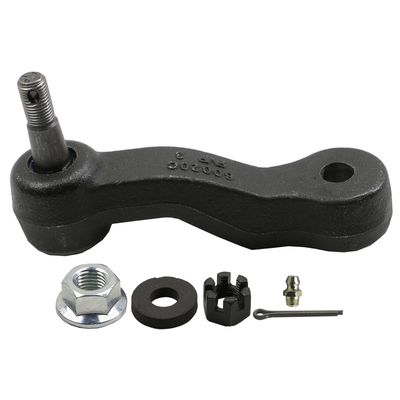The GM Genuine Parts 19178433 Idler Arm, like any idler arm, can show signs of wear over time, which may affect the vehicle's steering performance and alignment. Here are some common signs of wear you should look for:
1. Excessive Play or Looseness
- Symptom: When the idler arm is worn, it can develop excessive play or looseness. This can lead to a noticeable movement when you push or pull on the center link or tie rods.
- Check: With the vehicle safely lifted, try to move the idler arm up and down or side to side. If it moves significantly, it indicates wear.
2. Uneven or Rapid Tire Wear
- Symptom: A worn idler arm can cause the steering linkage to be misaligned, leading to uneven or rapid tire wear. You might notice that the tires wear more on one side or in irregular patterns.
- Check: Inspect your tires regularly for signs of uneven wear, particularly on the edges or in a feathered pattern.
3. Steering Wander
- Symptom: If the idler arm is worn, the vehicle may exhibit steering wander, where the vehicle drifts or pulls to one side without any steering input. This is because the idler arm can no longer maintain the proper alignment of the steering linkage.
- Check: When driving, if you notice that you need to constantly correct the steering to keep the vehicle straight, it could be due to a worn idler arm.
4. Clunking or Rattling Noise
- Symptom: A worn idler arm may cause a clunking or rattling noise, especially when driving over bumps or uneven road surfaces. This noise is due to the loose or worn-out components within the idler arm.
- Check: Listen for unusual noises from the front suspension or steering area when driving, particularly on rough roads.
5. Poor Steering Response
- Symptom: The steering may feel less responsive or more vague if the idler arm is worn. You might notice a delay between your steering inputs and the vehicle's response.
- Check: Pay attention to the steering feel, especially during quick maneuvers or when navigating turns. A worn idler arm can cause a lag in steering response.
6. Visible Wear or Damage
- Symptom: Upon visual inspection, the idler arm may show signs of wear, such as worn or cracked rubber bushings, corrosion, or physical damage.
- Check: Inspect the idler arm for any obvious signs of wear or damage, especially around the bushings and mounting points.
Summary
If you notice any of these signs, it’s important to have the idler arm inspected and, if necessary, replaced. Driving with a worn idler arm can lead to further damage to your vehicle's steering and suspension components, as well as pose a safety risk. Regular inspection and maintenance can help prevent these issues.
4o
Causes of Idler Arm Failure
-
Wear and Tear
- Over time, the constant movement and stress placed on the idler arm can cause its components, such as bushings and joints, to wear out. This is a natural process, especially if the vehicle has high mileage.
-
Corrosion
- Exposure to moisture, road salt, and other corrosive elements can cause rust and deterioration of the idler arm, particularly if the protective coatings or seals are compromised. Corrosion weakens the metal, leading to potential failure.
-
Impact Damage
- The idler arm can be damaged by hitting a curb, pothole, or other obstacles. Such impacts can bend or crack the arm, leading to failure.
-
Poor Maintenance
- Lack of regular inspection and maintenance can allow minor issues to worsen over time. For example, worn bushings or loose mounting hardware can go unnoticed until the idler arm fails.
-
Defective Manufacturing
- Although rare, it is possible for a manufacturing defect to cause an idler arm to fail prematurely. This could involve issues with the materials used or errors in the production process.
Signs of Idler Arm Failure
When an idler arm fails, it can manifest in several ways:
- Loss of Steering Control: The most serious consequence of idler arm failure is a loss of steering control. This could cause the vehicle to drift unpredictably or become difficult to steer.
- Severe Tire Wear: A failed idler arm can cause misalignment in the steering linkage, leading to rapid and uneven tire wear.
- Noises: A failing idler arm might produce clunking or rattling noises, especially when driving over bumps.
- Steering Play: If the idler arm fails, you might experience excessive play or looseness in the steering wheel.
Prevention and Action
To prevent idler arm failure:
- Regular Inspections: Have the steering and suspension system inspected regularly, especially during routine maintenance. Early detection of wear can prevent failure.
- Timely Replacement: If signs of wear or damage are found, replace the idler arm promptly to avoid a complete failure.
- Proper Installation: Ensure that the idler arm is properly installed and torqued to the manufacturer's specifications to avoid issues related to poor installation.
If you suspect that the idler arm is failing or has failed, it's crucial to address the issue immediately. Driving with a compromised idler arm can be dangerous, as it directly affects the vehicle's steering and stability.





Add New Comment